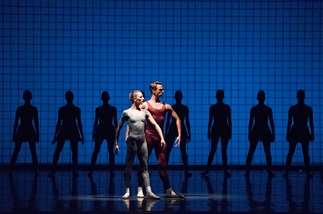|
Back
Words Come in an Easy Way Miami
Adrienne Arsht Center for the Performing Arts
01/13/2017 - & January 14, 15* (Miami), 20, 21, 22 (West Palm Beach), February 4, 5 (Fort Lauderdale), 2017
George Balanchine (Pyotr Ilyich Tchaikovsky): Serenade
Kenneth MacMillan (Richard Rodgers): Carousel: Pas de deux
Peter Martins (Charles Ives): Calcium Light Night
Jerome Robbins (Philip Glass): Glass Pieces
Lauren Fadeley, Jeanette Delgado, Jordan-Elizabeth Long, Jovani Furlan, Chase Swatosh, Samantha Hope Galler, Renan Cerdeiro, Nathalia Arja, Tricia Albertson, Callie Manning, Simone Messmer, Rainer Krenstetter, with soloists and members of Miami City corps de ballet
Opus One Orchestra, Beatrice Jona Affron (Conductor)
Steven Rubin, Jerome Robbins and Ronald Bates (Scenic Design), Karinska, Bob Crowley, Ben Benson (Costume Design), John Hall, Ronald Bates, Mark Stanley, Les Dickert (Lighting Design)

Glass Pieces: S. Messmer & R. Krenstetter (© Gene Schiavone)
Three company premieres and one of the most beloved of all ballets make quite a program. Beginning with Balanchine’s signature Serenade is naturally surefire. But as many times as I have seen it this work has never seemed as powerfully performed. Of course it is always easy to see new things even though you thought you were so familiar. This time there were water elements that had previously escaped me, and the final movement’s tragedy never felt as moving. This was in no small part because of the intense though always elegant acting of Lauren Fadeley and Jordan-Elizabeth Long. One always gets a thrill to hear audience members gasp when the curtain rises on Serenade, though rarely in any theatre experience have I felt such focused concentration. At intermission the reactions of first timers seated nearby was that they thought this was a new work. It is comforting to relive one’s first Serenade. Perhaps my own reaction was influenced by viewing it from an angle I never before had. Serenade is arguably the most beautiful ballet ever created.
Next we were given a pair of Pas de deux. The one from Carousel features a section of the second act from the production that Kenneth MacMillan choreographed for a 1994 revival. Of course he was influenced by the original Agnes de Mille, but when comparing MacMillan to the original (contained in the 1956 film version) there is a pronounced difference. MacMillan has a sense of abandon that is almost terrifyingly romantic. Samantha Hope Galler has not yet gained complete conviction of the Louise before she meets her lover. But Louise’s later romance and heartbreak were felt thoroughly; Chase Swatosh was the ultimate of dangerous lovers making his leaps suave and sexy. Let’s hope this lovely piece remains a repertory mainstay.
This work was paired with Peter Martins Calcium Light Night. This is the first time I experienced it though I remember the press sensation it caused nearly 40 years ago. One might wonder if that commotion maintains its significance today. Just as with Serenade the answer is in the impassioned audience reaction. The music of Charles Ives is difficult for many to appreciate simply as a listening experience. But it works perfectly for the quirkiness of Martin’s imaginative choreography. It is fascinating to watch Renan Cerdeiro and Nathalia Arja as they explore their space. When they dance together it is as though they are in a speeded up silent movie. How breathtaking when the athlete and artist often collide in order to create a touchstone in dance. It is amazing to see these dancers together. When they first entered Miami City Ballet their greatness seemed evident. Yet each season we are startled as each improves upon perfection.
Completing the afternoon was Jerome Robbins’ Glass Pieces, a three movement ballet that though not having a specific narrative is full of ideas and insight. The first movement shows the average person simply walking to who knows where; it looks natural and healthy. Among the walkers are standouts eventually forming three groups of men and women moving together beautifully as the others continue their trek sometimes jumping for joy. The second movement is a Pas de deux, almost severe at times, performed in front of a line of women who move methodically along a set that resembles large graph paper. The third movement is again like the first yet now the movement no longer feels free; it has become aggressively regimented. What does all of this mean? It is thrilling enough not to care but what looked comfortable has been transformed into something strictly controlled. Perhaps it has morphed because of technology. What matters is what you think. But you will enjoy the experience regardless.
This unforgettable program used the music of composers as varied as Philip Glass, Richard Rodgers and Tchaikovsky. This was a massive challenge for Opus One Orchestra and its guest conductor Beatrice Jona Affron who led with a command we have grown used to with this orchestra.
This program will be repeated at the Kravis Center in West Palm Beach January 20 through the 22nd. It will also be given at the Broward Center in Fort Lauderdale February 4 and 5.
Jeff Haller
|